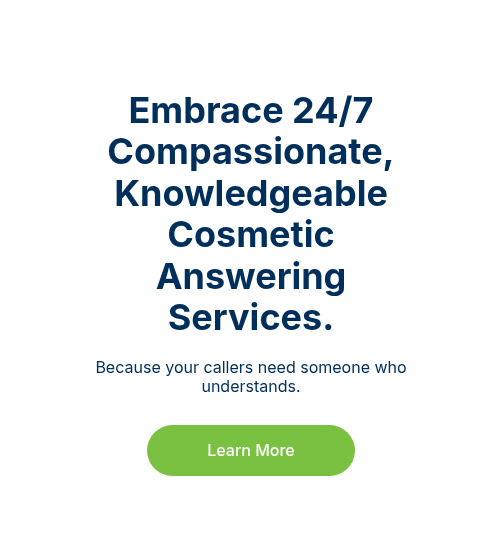The cosmetic industry works in a uniquely sensitive space—your patients are reaching out about deeply personal concerns that often touch on self-image, confidence, and vulnerability. Whether someone is inquiring about rhinoplasty, seeking treatment for severe acne scarring, exploring non-invasive anti-aging solutions, or considering body contouring after massive weight loss, they’re taking a significant emotional step just by picking up the phone to call your cosmetics practice.
These calls represent moments of bravery. Your patients may have spent weeks, months, or even years contemplating their decision before dialing your number. They might be anxious about being judged, nervous about the financial commitment, or uncertain whether their concerns are “serious enough” to warrant professional intervention. The person who answers that call—and how they handle the conversation—can either validate the patient’s decision to reach out or reinforce their hesitations. In this blog we’ll explore the core expectations that matter most to your cosmetics callers, as well as how to evaluate your current practice for those expectations:
- Compassion
- Knowledge
- Trustworthiness
- Responsiveness
- Evaluating Your Cosmetic Customer Service Practices

Compassion
Compassion is at the heart of every successful interaction, especially with your cosmetic practice. Your callers may be healing from experiences that have impacted their physical appearance and self-esteem, whether from past trauma, long-held insecurities, aging or medical conditions. It is crucial to meet their vulnerability in calling your practice with compassion, which will immediately make them feel more at ease.
Compassion also means creating a judgement-free atmosphere where patients are comfortable sharing their reasons for booking and concerns about the procedure. When seeking cosmetic procedures, many people worry about coming off conceited, shallow, or overly concerned with their looks. Patients are reassured by a caring approach demonstrating that their goals are respected. This may sound like, “I completely understand why this is important to you,” or “Many of our patients have expressed similar concerns before their consultation.” These simple acknowledgements validate the patient’s experience and create emotional safety.
According to research published in the Aesthetic Surgery Journal, physicians with the best patient communication skills receive the highest patient ratings and satisfaction. This emphasizes the need for compassion to be a fundamental component of your patient communication approach rather than an afterthought. When your team shows genuine care and understanding, they’re not just scheduling appointments; they’re starting a therapeutic relationship that will carry through the patient’s journey with your business.

Knowledge
Compassion creates connection, but knowledge builds credibility. When patients call cosmetic practices, they want to speak to someone who understands not just the basics of appointment scheduling, but the nuances of cosmetic treatments, terminology, and practice-specific protocols. Patients want an experienced resource who can speak their language and confidently walk them through the next stages so that they feel confident moving forward with your practice.
Understanding the patient journey in your particular practice is another aspect of knowledge. This means knowing typical wait times, what to anticipate from a patient’s initial visit, which procedures require multiple appointments, and any preparation or downtime that may be required. For example, a patient who calls to ask about laser tattoo removal should be informed that this usually calls for several treatments separated by weeks rather than just one. Giving background information on the first call shows your clinic is well-organized, professional, and patient-focused while also helping to set realistic expectations.
According to the American Society of Plastic Surgeons, patient education is important to both safety and satisfaction during cosmetic operations. Your team may turn a straightforward scheduling call into an informative encounter that boosts patient confidence and gets them closer to arranging their session when they show a good understanding of your offerings. By ensuring that patients arrive at their appointments prepared, informed and confident that they have picked a practice that values competence at every level, this knowledge strengthens rather than replaces the doctor’s medical expertise.
Trustworthiness
Trust is the currency of the cosmetic industry, and it must be acquired immediately—often within the first few minutes of that initial phone call. When patients call your office, they are getting ready to share personal information about themselves, trust you with their appearance, and invest thousands of dollars on elective procedures. They need to know that the person on the other end of the line is trustworthy (and has their best interests in mind) before they take any of those actions.
The most basic level of trustworthiness in conversations about cosmetic procedures is privacy and confidentiality. By managing these calls, setting proper limits, and practicing privacy policies, your customer service team should act with the utmost professionalism.
Transparency regarding procedures, prices, and achievable results are further indications of trustworthiness. Patients who call with budget questions or looking for price ranges should receive honest, direct answers rather than evasive ones intended only to get them through the door. If your practice accepts certain insurances, this information should be readily available and clearly communicated. The goal isn’t to have the full financial conversation on the first call, but to establish that your business runs with integrity and won’t shock patients with hidden costs or coercive tactics once they’re in the consultation room.

Responsiveness
Being responsive is becoming a basic expectation in customer service. Patients calling your cosmetic practice are typically researching several providers at once, and the timeframe in which they'll make their choice may be shorter than you expect. Someone who has finally mustered the guts to ask about a surgery that they have been thinking about for years may lose interest if they are met with voicemail systems, long wait times, or wait days for a callback. Practices that understand that speed is important gain a major competitive edge.
Research from the American Journal of Managed Care (AJMC) shows that clinic wait times affect not just overall patient satisfaction, but specifically the perception of providers and the quality of care. Building confidence in the first conversation is not just good for customer service, but also crucial competitive positioning for cosmetic practices. Customers choose elective procedures from a variety of providers. Patients are more likely to follow through with treatment, follow pre- and post-operative instructions, and become advocates who recommend your business to others when they believe they have contacted a reliable person.

Evaluating Your Cosmetic Customer Service Practices
Understanding what callers want is only the first step—the real effort is to honestly assess how effectively your practice currently matches those expectations and identify specific areas of improvement. This evaluation involves looking into your practice’s phone conversations and collecting data from many angles.
Begin by listening to your own phone conversations. Listen for what isn’t stated as well as what is expressed. Do your staff members show genuine care, or do conversations feel rushed? Do they confidently respond to questions concerning procedures and protocols, or do they often place callers on hold to obtain information? Are there any awkward pauses, unpleasant silences, or instances where the conversations lose momentum? Answering these questions provide crucial insights into the genuine patient experience.
From there, consider numbers that show performance patterns over time. What is your call answer rate during business hours? How many calls go to voicemail? What is your average callback time for after-hours inquiries? How many initial callers convert to scheduled consultations, and how does this rate differ by team member, time of day, or call source? These quantitative measures supplement what you gathered about your practice’s phone etiquette, providing a comprehensive picture of your phone experience’s strengths and weaknesses.
This assessment helps to establish a baseline of awareness about your current service practices so you can map a clear path to where you want to go. If you want to create excellent phone experiences, you will not achieve this simply by recruiting the proper personnel. Success is the result of a thoughtful analysis of your present approach, planned improvement, consistent training, and a desire to prioritize caller experience.
Meeting Expectations for Success
Even though the phone call may last only minutes, its impact on your cosmetic practice success extends far beyond that interaction. Patients bring courage, vulnerability, hope, and often years of reflection to the conversation when they reach out to your office. Whether that bravery is rewarded or regretted depends on how your team reacts. To reward that bravery, compassion, knowledge, trustworthiness, and responsiveness goes a long way.
With patients becoming more savvy consumers who do a lot of research before making a commitment, the competitive situation in the cosmetics industry is only getting more intense. In this environment, clinical quality alone isn't enough; added communication excellence meets patients right where they are and creates confidence. Your commitment to communication excellence honors the courage it takes for someone to reach out. By providing knowledge, compassion, and genuine support, you empower patients to confidently pursue their aesthetic goals.





